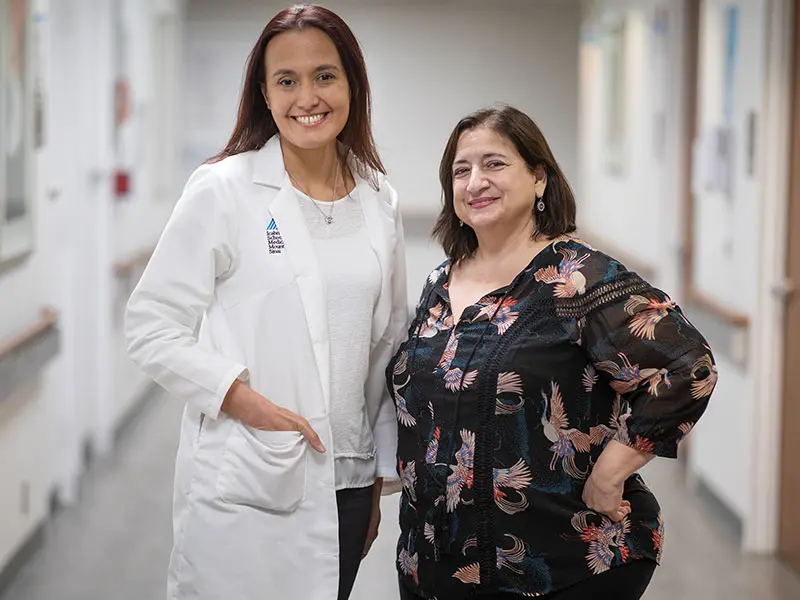• EPPIC-Net is a National Institutes of Health’s Helping to End Addiction Long-term (HEAL)-funded consortium established to accelerate the development of non-addictive pain therapies by supporting early-phase clinical trials of promising agents.
• Drs. Robinson-Papp and George led a team to create the platform protocol for this trial, a novel approach that includes multiple subgroups and substudies and enables the evaluation of more than one investigational agent. Testing of the first two agents is anticipated to begin in early 2022.

Jessica Robinson-Papp, MD, MS, left, and Mary Catherine George, PhD
An estimated 34 million Americans have diabetes, and painful peripheral neuropathy affects up to a third of them. “This pain may be experienced as burning, aching, hypersensitivity to touch, or simply as pain. There are four U.S. Food and Drug Administration-approved medications that reduce symptoms but many patients have tried these and do not get adequate relief,” says Dr. Robinson-Papp.
A novel approach enables simultaneous testing of multiple agents.
One agent is a molecule that may increase nerve fiber density.
The two agents are:
Topical pirenzepine 4% (WST-057), a molecule that was developed in the 1980s and marketed throughout Europe and Asia in an oral form to treat gastric ulcers, and has potential as a topical pain treatment.
NRD135S.E1, an oral active drug that has shown some indication of potential pain relief for diabetic peripheral neuropathy.
The pirenzepine Phase 2b study is a multicenter, parallel-arm, randomized trial that is open to patients who have diabetes and who both exhibit signs of peripheral neuropathy on exam and present with related pain.
• Using a premeasured pump, the treatment cohort will apply the topical therapeutic to their feet and lower calves once daily before bed, and the control arm will apply a topical placebo.
• Participants will wear digital monitors to enable assessments of their activity and sleep patterns, and use a smartphone app to provide daily updates on the level of pain they are experiencing based on a scale of zero to 10.
• Participants will also undergo neurological exams and quantitative sensory testing, which will involve both vibration and temperature, to better understand the phenomena of numbness and pain.
The study plans to recruit 260 participants who will be followed for 20 weeks. The primary outcome is pain, but a secondary outcome is treatment of the underlying disease process. “There are preliminary data for this therapeutic agent that suggest this type of molecule can increase the density of certain nerve fibers and that it might help nerve regrowth at 20 weeks,” explains Dr. George, Clinical Research Program Director, Department of Neurology, Icahn School of Medicine at Mount Sinai. “Based on those data, we are targeting a slightly milder-pain population because if the neuropathy patients' experience is too severe, that regrowth may not be effective.”
NRD135S.E1 is an interesting therapy that has its roots in a tea.
For the multicenter NRD135S.E1 study, 260 participants with moderate to severe neuropathy will be recruited and randomized into two cohorts: one that will be administered the oral active drug once a day, and one that will receive a placebo. Because the active drug is novel, participants will undergo additional monitoring; they will be administered their first dose in the clinic and then have their vital signs taken and undergo an electrocardiogram. They will also have an earlier initial follow-up.
“It is an interesting new therapy that has an unknown mechanism of action,” says Dr. Robinson-Papp, Professor of Neurology at Icahn Mount Sinai. “It has its roots in a tea that was taken in a Siberian village for pain relief. Researchers identified a bacterium that was producing a particular molecule of interest, synthesized it, and put it through preliminary testing.”
An additional notable aspect of these studies is that biosamples from consenting participants will be stored at a data-coordinating center at a participating clinical trial institution. This has the potential to enable both identification of biomarkers of pain and key insights on peripheral neuropathy among different patient populations, according to Dr. Robinson-Papp. “For example, we could gain a better understanding of how a medication’s mechanism would work in different subgroups of patients allowing us to move toward personalized medicine,” she says.
In addition to those potential benefits, Drs. Robinson-Papp and George say that having a platform protocol in place—rarely used outside the realm of cancer research—creates a standardized, rigorous process for assessing these, and other, pharmaceutical agents that could accelerate time to market.
“For many small pharmaceutical companies, a phase 2 study is a significant cost risk,” Dr. George says. “Through the protocol, we have an efficiency of design that, combined with EPPIC-NET and HEAL, creates a quick, efficient approach to assess new therapeutic options and also potentially explore whether certain combinations of therapeutic agents are efficacious.”
